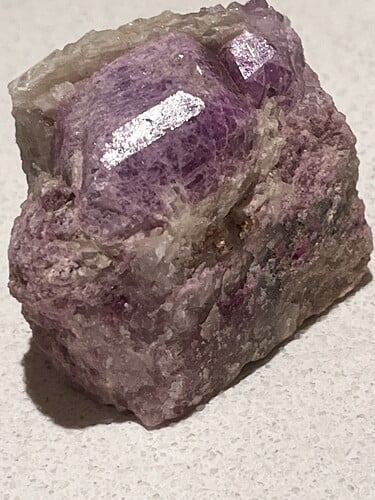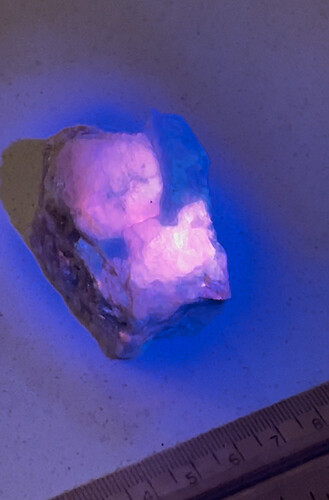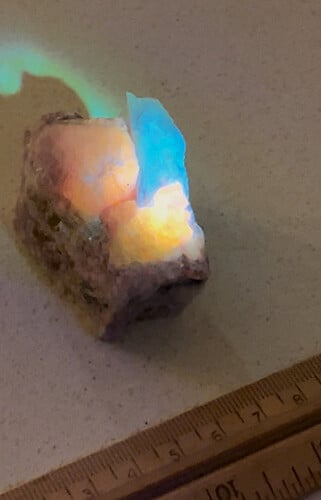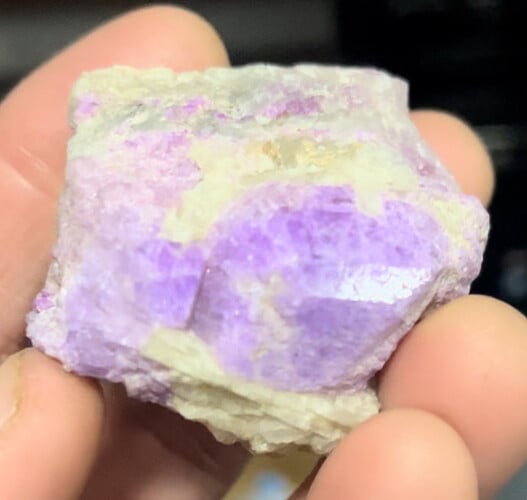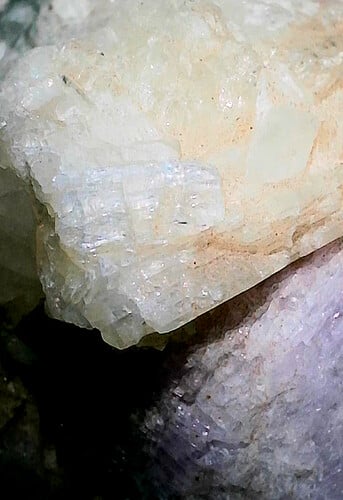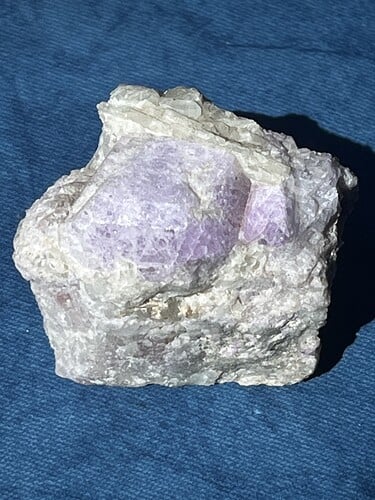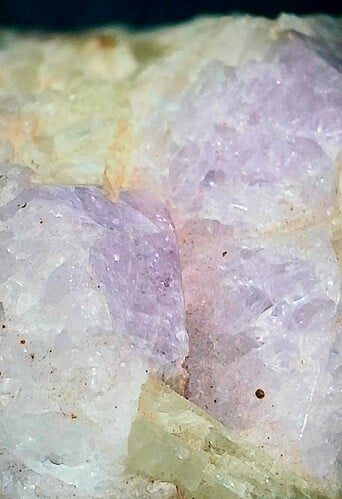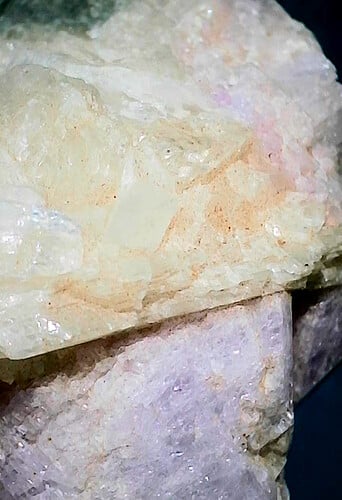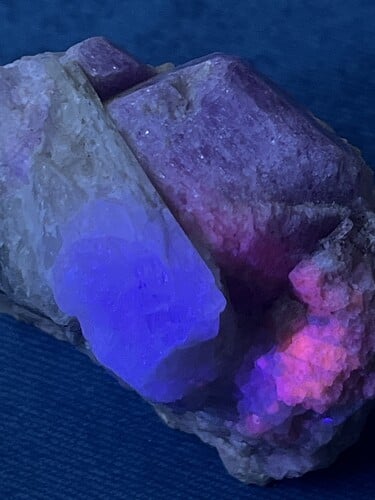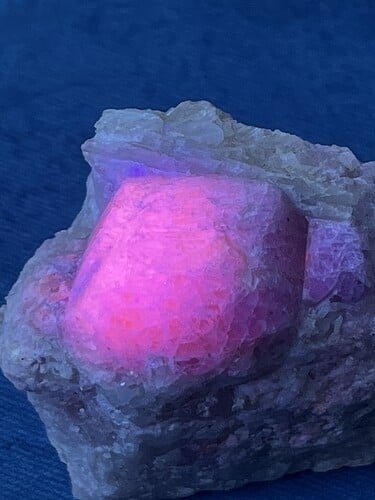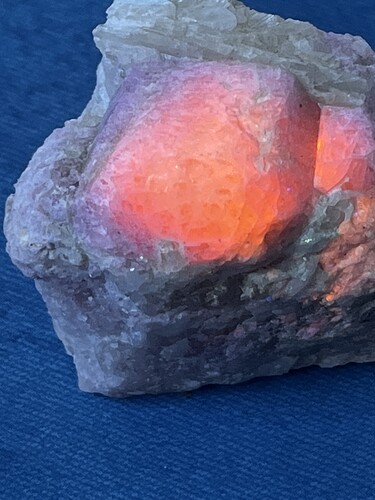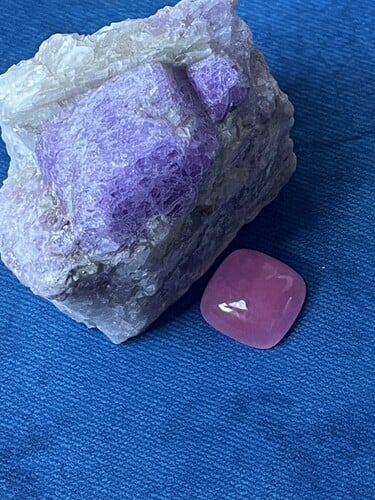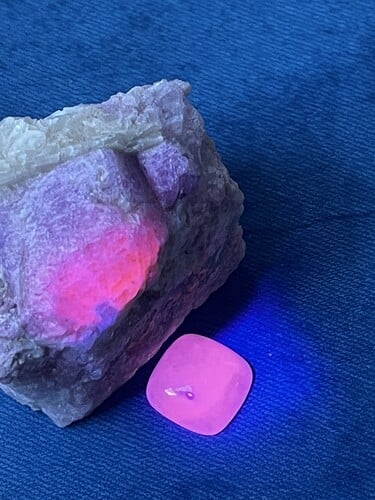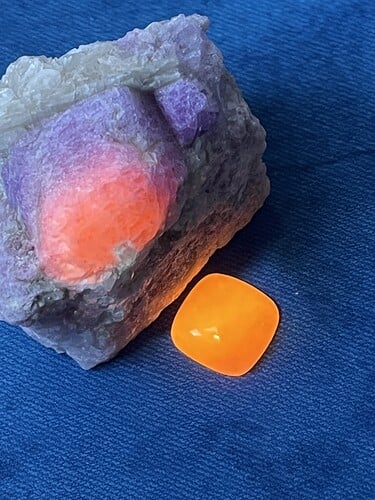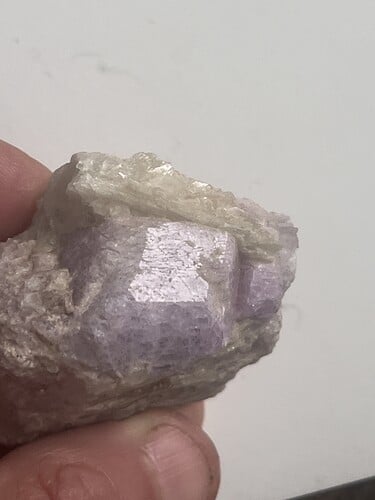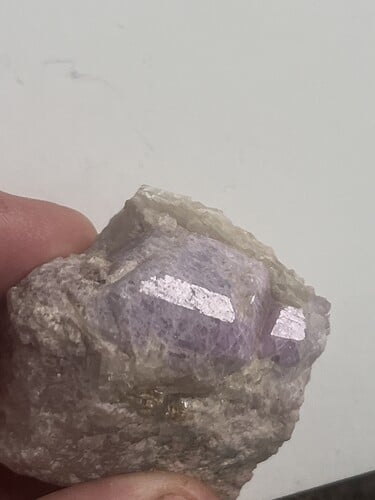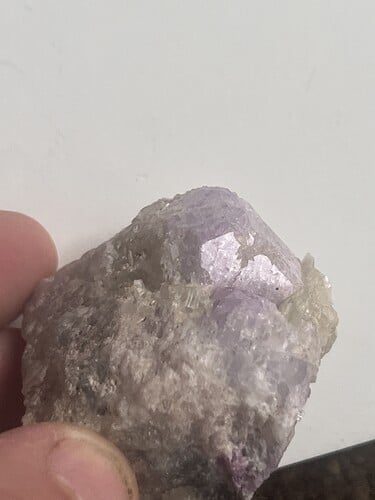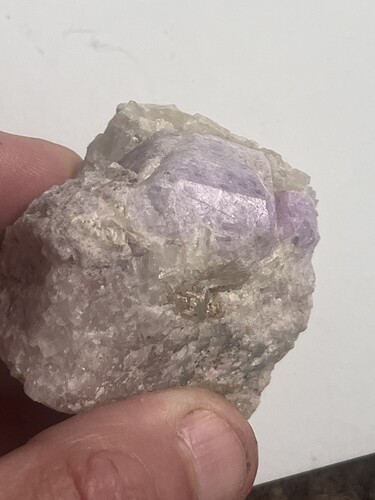I was in central California rock hunting this past week in a few regions with interesting geological and paleo-climatological history. I found a bunch of exceptional (to me) jaspers, jades and other stones, but I think I got really lucky and found this stone; something I did not know existed, and only learned of its existence through an unrelated meeting with a local gem expert. I brought it along and as soon as she saw it, she said she thinks she knows what it is and stuck it in a sealed UV box for maybe 10 mins while she tested other stones. When she brought it out of the box my jaw dropped, I have never seen anything like it. Note that I am an amateur so maybe it’s not that unique to others, but I couldn’t find references to similar stones found in California, most seem to come from Afghanistan with the closest example I found coming from Ontario. The spot where I found it could not be more remote, the population probably averages about one cow per square mile and maybe a couple dozen people (at most) within 10 square miles of the find spot. I would never have thought to put it under UV for 15 mins, so identifying it was truly a fluke, but one I’m super thrilled happened. Does anyone know if these are indeed known to exist in California or western North America?
Hackmanite is a sodalite family mineral. It contains sulfur in addition to chlorine… It’s occurance is associated with silica undersaturated igneous rocks. Coyoto peak in Humbolt county is a diatreme of ultrabasic low silica rock which contains sodalite. I would not expect it to be found in association with nephrite or jadeite which is found in the same area in an obducted ophiolite associated with a low temperature high pressure metamorphic regime. There is an occurance of lapis lazuli which is a mixed sodalite family rock in San Bernadino county… The only other area in California that I can think of that has low silica rock is in the Mohave Desert… Mountain Pass mine is a carbonitite, the area was explored for more rare earth minerals and a low grade source was found in a swarm of shonkinite dikes south of Mountain Pass. Sodalite minerals could potentially be found in association with these alkaline igneous rocks. The geology of California is very complex but is not known for much alkaline igneous rock intrusions where sodalite is most often found.
Thanks for the detail, very helpful.
This was found in San Benito county, northeast of the city (town) of San Benito in what I believe can be called the southern end of the Diablo range. There is a lot of jade and jasper in that area, you know far more about the geology than I do, but that much I know. All of this (all the stuff I found) is in secondary deposits, and given the paleo-climatic and geological history of the region, its source could be pretty much anywhere within a few thousand miles radius west of the Sierras (as a swag). There are quite a few alluvial and seismic crevices (if that’s the right word) that cut roughly 5 to 20 feet vertically allowing one to see clearly that there are no differing geological strata for at least those depths at those altitudes, it’s all one thick alluvial layer. In other words, whatever the geological history, there was a period where many meters of soft, mixed sediment accumulated that one can easily hack away at with a pick. It’s basically compressed dirt, sand and grit, with harder stones mixed in. There are many red jaspers and what I believe to be blueschist or some other hard blue-ish host stone(the host stone usually associated with benitoite (which, sadly, I found none of), both of which have distinct, bright white veins of what may be calcite, serpentine or some other mineral.
The jades I found are mainly a soft greenish-gray, some of which have thin white veins of some material separating sections of the jade in the host rocks (which, in this case, were of various earthy tones, with some red and green mixed in here or there.
To try and say that yet another way, unlike the rocky higher elevations or more northern hills of the Diablo range, where hard rock strata of various geological epochs can be clearly seen, this region is not like that. It’s basically as I described, which is nice because stones that are not dirt/sand really stand out.
Sorry if that’s a non-scientific description, and I am totally open to being wrong on my assumptions regarding the geological history of that region, but that’s what I observed and since I had an expert view the stones I mentioned above, I feel pretty confidant they are identified correctly (but again, I could be wrong on many things).
I think the stone in the pics was a really lucky find, it’s the only one of hundreds, or maybe thousands, I collected. Once i learned was it was, I went through all of those again and this one is singular. I really like it, it’s just way cool, IMHO, so please excuse my enthusiasm.
One other thing that may be worth mentioning is that I collected quite a few carved and pigmented stones, a couple are clearly microlithic cutting tools, but most likely had some ritualistic meaning, as they are all part of a body of recurring motifs I track, so I am familiar with them in various mediums in different regions. These were all localized; that is to say, the same motifs/tech/techniques as I’ve seen elsewhere, but done with local stones, like the jades and jaspers I mentioned earlier. That’s a much longer discussion but happy to share details off line if you are interested.
I’m happy to send picks of any of this stuff, please PM me and i’ll send whatever you’d like to see.
Thanks again for the additional insight; it’s always greatly appreciated.
there’s a syenite body that intruded blueschist near the benitoite mines, as shown on the USGS rock maps… alkalic syenite could be the source of sodalite. the area is blueschist facies metamorphic oceanic floor basalts, mostly serpentinite. the high pressure, low temperature metamorphic grade accounts of the jade found there… it is jadeite jade but not of gem quality… benitoite itself is a secondary hydrothermal mineral… extremely rare as barium, an incompatible trace element has to be scavenged from metamorphosed thoelitic basalt which is barium poor.
even though jadedite and sodalite are sodium barely silica saturated to unsaturated minerals, they are not found in association with each other to my knowledge. Neptunite is found in association with benitoite in natrolite veins cross cutting glaucophane schists… it’s also found in association also with sodalite… so it’s quite possible that your sodalite crystal came from the same geological setting as the neptunite…One would have to do an extensive field search to find natrolite veins containing one or both minerals. Probably has already been done by weekend prospectors looking for benitoite…I would have to say that your crystal could very well come from that area.
One interesting note: the Pinnacles National Park is half of a rhyolitic volcano, cut in half by the San Andreas Fault and transported almost 200 miles north of the Neenach Mountains north of LA… the Neenach is the other half left behind… the volcano dates to the Miocene, between 23 and 5 million years ago…that means that the fault offset the mountain by almost 200 miles in a maximum time of about 20 million years…about an inch or more per year, as fast as fingernails grow.
I found another reference. There are alkalic igneous intrusions in the San Benito mountains. Nepheline syenite, an under saturated rock is there, along with some other small alkalic intrusions. These are in the same area where benitoite was mined. Sodalite minerals definitely are associated with nepheline bearing high sodium, silica unsaturated rocks… sodalite is found there. The crystal could very well be hackmanite as long as the matrix material has no free quartz, crystalline or otherwise as unsaturated minerals react with quartz to form albite out of nepheline, sodium rich feldspar out of sodalite… crystal form is isometric, with some dodecahedral habit…it’s difficult to tell from the picture whether it’s cubic or not…the crystal form looks somewhat like garnet crystals which are isometric also…
Paul,
That is an amazing find! The specimen is displaying the typical tenebrescence behavior and isometric crystal structure common for Hackmanite.
Finding this in California is not common and as @StevenH26783 pointed out, very few geology-centric papers discuss locality in the state.
Recent discovery in Canada. This is a good read…
Cheers!
Thank you, Troy, I had heard of this discovery but I had not read that paper and I agree, it is excellent; very thorough and insightful.
I do not have the expertise or equipment (or time) to analyze at that level but I may ping some local universities to see if anyone is interested in taking a look at it. I so wished I had found more, I brought a few buckets of stones back with me, but alas, just the one. I do remember pretty precisely where I found it (within, say, 200m or so; if you’ve ever wandered about in a region far from home staring at the ground while looking for stones, you know you can cover a lot of ground before realizing how far you’ve wandered :-).
The effect you mention, tenebrescence, was new to me, which is probably why I got so excited by it. It almost defies the last of material science as I knew them (an admittedly low bar, LOL). What is interesting to me is that 1. the very bright orange glow under UV (both short and long wave), 1. it does more than simply change in appearance (taking on the blue/purple color of lw UV), it retains a slight “glow” for quite some time after the light is removed; that is to say, it radiates those colors, it’s not just a passive absorption/reflection of ambient light), and 3. how long the effect lasts (many hours actively radiating those colors, and, as of this moment, a few days retaining the color, albeit faded). I’ll stick it in a dark box and see if it reverts to its original color, but so far, that has not happened. It’s very cool, IMHO.
Anyhow, thanks so the link and comments. As always, much appreciated.
Thanks for the additional detail, I will check out the USGA site as well.
I think you are right that the bright white is neptunite, it is very distinct from the calcites i am familiar with, a beautiful white, with, to my eyes, a very subtle bluish quality. I have this hang up over smashing up rocks I find (it’s kinda will), so I have not broken off a piece yet to test it, but I’ll try and get over that and share results. Similarly, it’s hard to get a flat surface and a color/luster conducive to measuring RI for the stones I mentioned, but the SG and hardness line up as I described them. i ordered some diamond cutting wheels for my rotary tool which should allow me to get good, testable samples. I also found a bunch of other mystery crystals I cannot identify but will put to the test when I get the blades. I am guessing many are quartzes, but a few look quite distinct. For example, I found one crystal covered rock that has a green color coating the surface, which I thought was a moss or some microorganism, but it wouldn’t wash off, and under 10-100x magnification, it’s clearly a tiny layer of green crystals that mix in with the white “host” crystal. They are way too small to be cut into gemstones, but it may be possible to get a nice slice of the white/green together and, in the right hands, get a cool looking stone out of that.
Anyhow, sorry to ramble. I have not been to Madagascar or Burma, but I’ve been to many other places rich in geological diversity and known as key sources of gemstones, but I gotta say, the US is blessed in this regard to a degree probable unmatched anywhere else, it just hasn’t had many millennium of extensive mining like those other places. Which makes it very special.
The gem expert seemed pretty sure of it, but funny enough, she was so sure she didn’t bother measuring with her spectrometer. It’s worth repeating: I am not an expert and may be wrong about this, so I appreciate the detail. Can I send close ups or measurements to help you evaluate further? The faces of the main fluorescent section are glass-flat, so I can probably get an RI on that. I can also probable find a small section where I can test hardness. SG is not going to happen, cuz I don’t what to cut it, I like it like this, and I don’t know the percentage of X vs Y or Z minerals in the rock, so I can’t mathematically reverse engineer a SG value. Whatever it is, the effects are unambiguous, and it glows with a far greater intensity under UV than the most fluorescent ruby I have. The only comp I have is a stone I once posted that may be Afghanite, but a spectrometer identification could not be made using an older unit that probably lacked that mineral in its reference database.
I’ll take some magnified pics, and maybe some group pics with other fluorescent stones and post, if anyone is interested. Thanks again, all, for the detail!
Here are some additional pics. In the UV shots, the first in sequence of pairs top to bottom is sw, the second lw. The first three shots below are in sunlight. The blue/purple color remains from when I last “charged” it yesterday.
Very interesting to me is that I compared with the highly fluorescent ‘afghanite’, or whatever it is, and the colors are darn close, if not identical. That one has a long story behind it, but it’s very ancient and was purchased by me from the source live (I bought it while there on-site) in a region central to the gem trade between the Near East and Asia, so it’s highly possibly it’s from Afghanistan, as were/are countless other gems traded in those regions.
Note the adjacent crystal(s) also fluoresce, but only with lw UV, and no where near as brightly or with the same colors.
Here are the comps with said ‘mystery stone’:
sorry for the deleted post… if I were in your place, I’d take it to a local geologist or a mineralogist. The matrix is just as important for ID’ng the stone as the stone itself. If it’s nepheline, odds are the stone is sodalite… hackmanite is not chemically different from sodalite… it’s the tenebrenescence that makes it hackmanite.
I also think that hackmanite has been found at Mont St. Hilaire in Quebec, close to Montreal… there’s a line of alkalic syenite/carbonatite intrusions marking a possible hot spot movement across southern Quebec. Each one is being intensely explored for rare earths and niobium… The one you have referenced is close to Ontario…it’s also a carbonatite body being explored/developed for rare earth mining. rare earth elements are indispensible for modern technology. Neodymium magnets are indispensible for EV motors and hybrid electric motors…China has 90% of the world’s reserves…Alkalic intrusions, particularly carbonatites concentrate rare earth elements into economically mineable quantities. Niobium will be essential for super conductive materials, currently used in mag-lev trains being developed in China… The US has only a few carbonatites and rare earth concentrations making us economically vulnerable…Besides the rare earths, thorium, uranium are also present in alkalic intrusions… alkalic rocks make for ore deposits, including copper, gold. silver/zinc/lead is found in hydrothermally altered alkalic monzonites world wide… however, not all alkalic intrusions are fertile… with carbonatites, 10% will be rare earth bearing… but it’s much worse for kimberlites, only 1% of them contain diamonds…
So far as gem minerals are concerned, rare minerals of all sorts are present in association with alkalic intrusions…dianite (russian blue jade), a variety of vesuvianite, charoite. apatite, flourite more commonly, some of of which can be of gem quality…
Paul,
Looking at the images you placed under UV, it reminded me that Spodumene is found in various locations in Cali, and also displays tenebrescence. It will fluoresce orange under both LW and SW. Although, it is a monoclinic crystal. The reference link shows common areas in California where it is found and if you were near one of those areas, that could put Spodumene on the list.
The crystalline shape of your specimen could be monoclinic versus isometric. It is hard to tell without mapping the dimensions of the exposed surfaces.
agree from the pix that it could be either monoclinic or cubic… made that comment earlier about the pix also… Don’t know if there are pegmatities in the area that would make spodumene. Undersaturated rocks cannot co-exist with over saturated pegmatites with free quartz…elements mobilized from granitic rocks by peralkaline intrusions include HFSE- Nb, Ta, U, Th, Zr, Hf, platinum group…the benitoite mineralized area is mostly blueschist derived from oceanic crust and hydrothermally altered. These rocks are poor in Li and quartz, so having spodumene as a possibility is less likely… good point though!..
Kunzite was found in California in 1902 by George Kunz and named after him in 1903. Multiple localities in CA host this gemstone.
The monoclinic habit of this particular variety of Spodumene (tabular and prismatic) may argue against, based on the specimen’s crystalline features. Other optical, color, and tenebrescence behaviors still provide strong clues towards Spodumene in general.
Some non-destructive gemology tests could help here.
most of the beryl locations that I know of occur in the southern sierra nevada. Jurassic age pegmatites, very young compared to most other pegmatities in the USA, were formed during the close of sierra nevada mountain building. The famous Pala tourmalines and recent Julian emerald discovery are from this area. I would be suprized that the geology of the New Idria mining district which highly complex and unique, would support pegmatite formation, even though beryl can’t be totally excluded…
I really think that that specimen should be taken to the closest UC or other university campus and have it looked at by academic geologists and mineralogists. As everyone always has pointed out, having it inspected by professions is worth ten thousand pictures!.. as more of the case than not, matrix minerals are just as important for mineral identification as mineral associations are ther rule. If the lighter material is nepheline or natrolite, the crystal cannot be beryl. if it’s quartz, then beryl would become possilble. I will suggest to PaulB to test the matrix himself for hardness by scratching… easy enough to do, nepheline and natroline are softer,…
test the matrix for quartz. TroyJ has suggested Beryl as another possibility for the crystal…sodalite,nepheline and natrolite have a hardness of 5.5-6… don’t scratch the crystal!
if quartz is the matrix, beryl become more possible… if the matrix is 5.5 -6, more likely to be hackmanite,PS even without the tenebresecence, sodalite in crystal form is rarely found. Also see my response to TroyJ… Good luck on a definitive ID… you might have found something entirely and previously unknown to the area you found it…That might also pqiue the interest of academics…many resources in california for mineral analysis… only one where I live.
A always, thanks for the info, I appreciate the details and they always lead to interesting insights.
To be sure, is your suggestion to bring the stone to UC because you think it may be of geological importance, or merely to identify it definitively? The reason I ask is that I kinda like it as-is and I’m fine without a definitive ID, but if you feel there may be some geological importance to it, I will gladly bring it to a local UC geologist. Do you happen to know one or have any suggestions?
One other thing you may find interesting is that I have resolved to build a spectrometer. There is an arduino microcontroller board that is pretty cool (ams AS7265x Smart Spectral Sensor Ambient light, Color, Spectral & Proximity Sensors | ams OSRAM). It has three discrete sensor chips, one for UV, visible, and near IR (410-940nm), and the matches LEDs on board to generate light in those bands for each sensor. It has 18 channels of wavelength bands that can be analyzed, and if I need more radiant light sources, I can easily add (the board has pre-cut slots for them). I’ll use an arduino microcontroller a the primary I/O processor, but it’s all standardize I2C interfaces per channel/sensor so I can send via serial or Wifi to IOS or a PC to both process and visualize. I’ll write the code, plenty of libraries exist so it should be pretty straightforward, and I can call via API one of several open mineral Raman Spectroscopy Databases to assign mineral candidates to the spectral analysis. The hardware is very precise, but there are naturally some limits the 18 band range, but it theoretically possible to use FFT to reproduce far more fine grained ranges. Either way, it should work quite well, even if there are not perfect “hits” in the mineral DBs, I still should be able to capture quite precise and easily visible spectral profiles. The only tricky part will be calibration, but I can use a number or known reflerence stones for that, and I think I can tune it to be prettt darn accurate.
All in (without an enclosure and the PC or IOS device costs), it’s about $115, including board, microcontroller, cables, Wifi Shield and microSD capture shield (optional, but may be helpful). I may need to add an I2C mux, which is cheap, to expand number of channels, but that’s cheap, and I may be able to do some or all of that in software.
It’s not directly related to this stone, that’s not why I’m building it, but I can certainly analyze this stone as well.
If you are interested, when it’s done I can post hardware BOM/wiring diagram and code. It is truly incredible the way very high quality, modular hardware like this is now widely available at reasonable costs to build something like this. The hw is probably far more advanced and sensitive than any pro spectrometer built before, say 2010 (a guess); it’s not a toy, it’s legit lab grade stuff. If it works, and I see no reason why it shouldn’t, it would mean pretty much anyone can have their own spectrometer for less than $150, and it will be portable and can be field hardened.
Pretty cool, right? There are clear limits to my knowledge of this stuff, so I am sure I can only take it so far, but I can post the code on github and opensource it so others can make it better.
I figured you may find that intersting. I welcome suggestions.
Hi Troy, I really struggle to understand how to “see” crystaline structure, and I long to figure that out. For the most basic stuff, like a single, long hexagonal crystal, it’s obviously obvious, but for anything but that, even if not “cabbed” or otherwise smoothed over so that the crystals are not discretely and obviously visible (either with the naked eye or magnified) I’m lost. By way of example, how would I identify the crystal structure of this. Below are some pics taken with the light angles to highlight some highest-order surfaces (the overall shape of the visible stone). Naturally, I can’t see what’s below them (the sides in the host rock) but can I deduce them from what’s visible? Also, are these outside faces representative of the crystal structure of the mineral, or are these supersets or sums of a smalls base crystal structure within the stone that when combines manafest this way (can I tell one from the other, or reduce one to the other, for example)? Any suggestions on this would be much appreciated!
Hi Paul,
@StevenH26783 is correct that Hackmanite is rarely found with good macro-crystalline form… but here is an example that has many similarities to your specimen, except this was found in Afghanistan.
https://www.mindat.org/photo-409946.html
After finding this image, I must say, Hackmanite has taken the lead in this exercise. ![]()
My suggestion about Kunzite being a possibility has fallen behind. It’s not out of the race yet but, definitely loosing ground.
As for mapping a crystalline object, I have been tinkering around with photogrammetry to model the crystal planes. And yes, another project that will be gemology focused. My latest rabbit hole attempt will be using: GitHub - openphotogrammetry/meshroomcl: MeshroomCL: An OpenCL implementation of photogrammetry with the Meshroom interface
We can take this part of the discussion over to the PM world to keep the forum traffic focused more on the gemology side of things for now. I suspect this will be helpful in other areas of research, too.
Cheers!
-Troy
